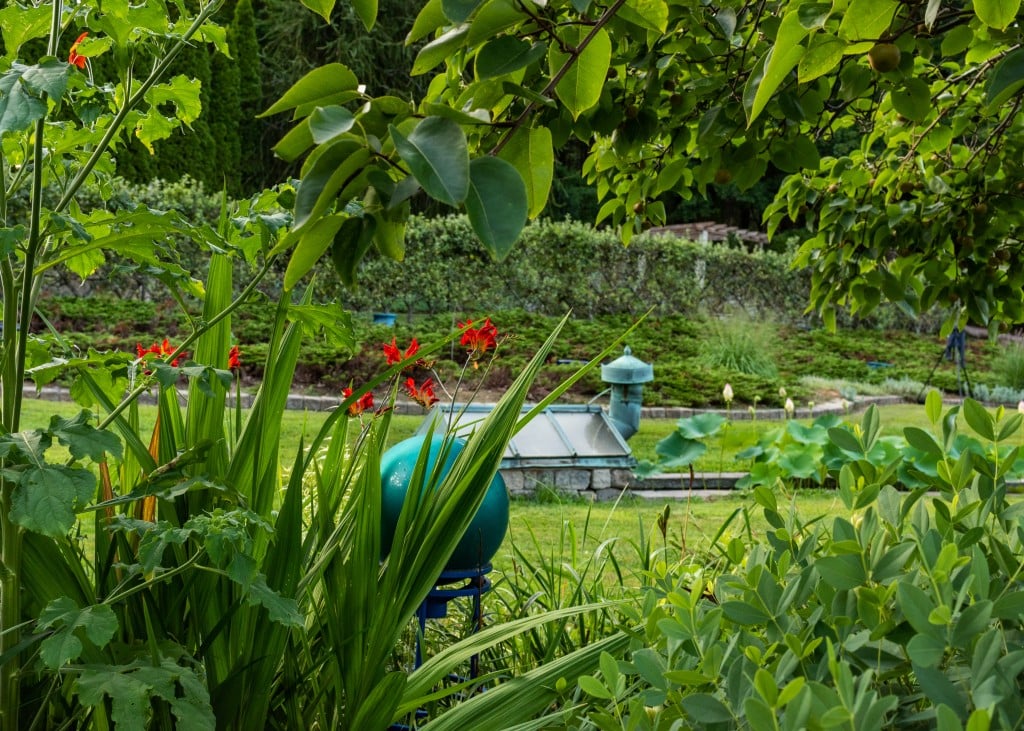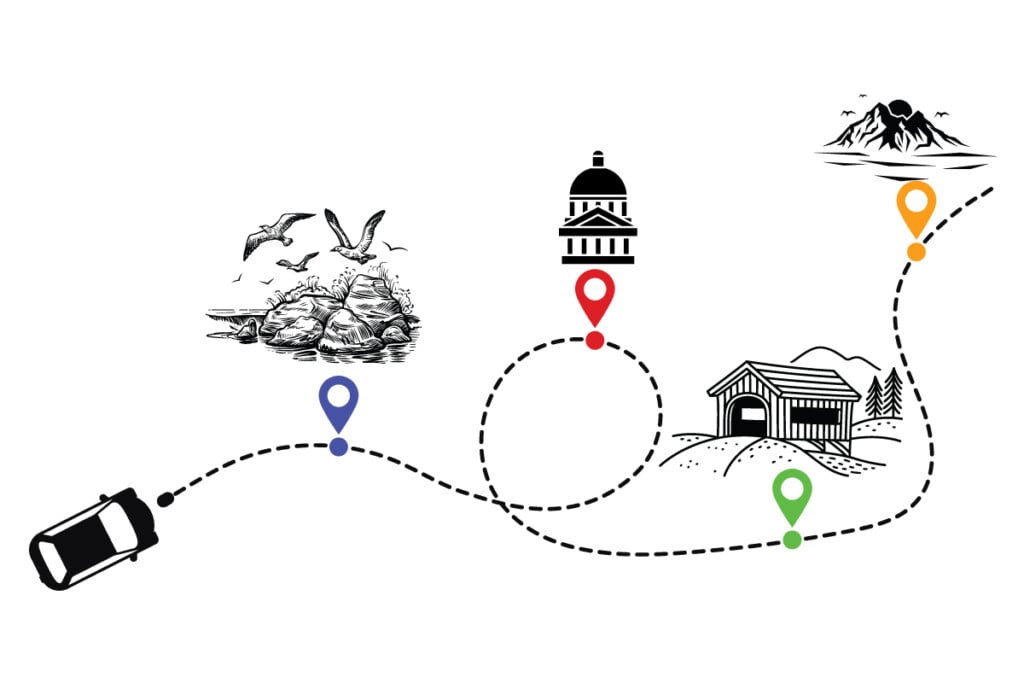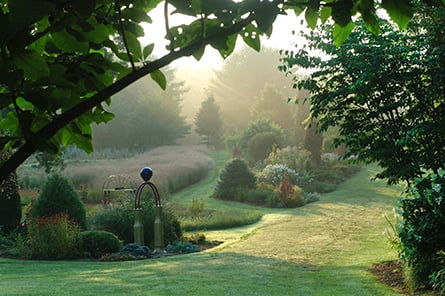The Villages of Antrim
A textbook example of a New England small town

Antrim’s town hall features murals on its tower. Photo by Stillman Rogers
The most visible sign of Antrim, for those of us who travel frequently along Route 9 between Concord and the Monadnock Region, is the row of white wind towers spinning atop the ridgeline of Tuttle Hill. These turbines, which generate enough energy to power more than 10,000 homes, have also generated mega-controversy — opinion in town is still as sharply divided as it was during the application process.
But most of Antrim is not visible from busy Route 9. To find its villages (and there are several), we headed south on Route 31 to a scattering of buildings around a crossroad at the town’s geographical center. Appropriately, this is Antrim Center, and the site of the original settlement.
The Grange Hall at the crossroads was once the meeting house, built in 1785, and it stood atop the hill behind it. The town had been incorporated only eight years earlier, in 1777, and was named for County Antrim in Northern Ireland. That was the former home of landowner Philip Riley, one of the early Scotch-Irish settlers.
Antrim’s history differs from most of New Hampshire’s early towns, which were mostly settled by people from England. In 1718, a large group of Scottish Presbyterians, who had been living in Ireland, migrated to Boston, and later to what is now Londonderry. From there, smaller groups spread west, one settling in Antrim in the summer of 1744.
Three years after the meeting house was built, about 60 settlers, most of Scottish ancestry, established the First Presbyterian Church, holding services in the meeting house until their new brick church was dedicated in 1826. For almost 40 years, it was the only church in town, and around it were a store, post office, schoolhouse, tavern, parsonage and several houses.
In 1798, a house just east of today’s Grange Hall became a hotel and tavern; this and local homes hosted summer boarders who arrived in Bennington by train and came to Antrim Center by the daily coach. The building was replaced in the 1840s by a farmhouse that today again hosts guests as the Uplands Inn.
By the late 1800s, the manufacturing at the mills along the falls of Great Brook caused a population shift to South Antrim, soon making it the town’s commercial center. Early mills sawed lumber and ground grain for flour, and at one time more than 20 mills stood between Gregg Lake and the brook’s junction with the Contoocook. These included, at various times, woolen and silk mills, a shovel factory, a tannery and mills making shoe pegs, hoes, mirror frames, window blinds, powder kegs and furniture.

A closer look at one of the murals on the town hall tower. Photo by Stillman Rogers
The Goodell Company was the largest and longest lasting, beginning in 1851 with the manufacture of cast iron apple peelers, branching into knives and other cutlery in the 1870s. It was the town’s largest employer for more than a century.
By the late 1800s, largely thanks to the Goodell Company, Antrim’s hub was well established in the South Village. With most of the congregation living there by then, the Presbyterians built a new church next to the Maplehurst Inn. A brick town hall was built opposite to them.
Today, the dramatic architecture of the First Presbyterian Church, the mansard- roofed inn, the town hall (look for the murals on the tower) and the traditional white-
steepled Baptist Church are the focal point of Antrim. Extending along Route 31 are two homes adorned with Victorian “gingerbread” fretwork, and the Antrim Church of Christ, an eye-catching shingle-style Victorian with stained-glass windows all around. These, together with the 1908 Colonial Revival library and the remaining brick mill buildings, form a textbook of late 19th- and early 20th-century small-town architecture.
Meanwhile, back in Antrim Center, in 1898, the Congregationalists built the lovely little Stone Church out of local fieldstone and added stained glass windows. After serving the congregation for a century, it was saved from deterioration by the Rymes family, and is now the home of the nondenominational At the Cross ministry.
Throughout town are attractive signboards with historical information, and upstairs in the James A. Tuttle Library is the museum of the Antrim Historical Society. This active group, along with its other projects (including an oral history archive and historical catalog of local houses), maintains a collection of newspapers chronicling daily life here from 1875 to 1951. Annual society activities include the Reading of the Declaration of Independence at the Bandstand in Memorial Park on July 4th.
Not all of Antrim’s mills were on Great Brook. At the former village of North Branch, where today’s Routes 9 and 31 intersect, that stream had its own mills, and one of them stood at the start of one our favorite hiking trails.
The first mill at the falls of North Branch was built in 1798 by one of the settlers from County Antrim, and, over the years, expanded from a saw and grist mill to making pails and barrels. In 1864, Josiah Loveren bought the mills and produced lumber, shingles and siding. Subsequent owners produced dowels for cribs, cable reels, and the boxes that held the “talking” mechanism for Mama dolls.

The Maplehurst Inn was built around the turn of the 18th century. Photo by Stillman Rogers
A hiking trail begins near the mill site, off Loveren Mill Road, where the foundations of the mill as well as remnants of the dam and sluiceway are still visible. The trail leads along the river, then into the forest to an Atlantic white cedar swamp, reached by a boardwalk that sits above a fragile habitat of sphagnum moss, Labrador tea, leatherleaf, snowberry, tamarack and balsam fir. Such habitats are rare in New Hampshire, and this is one of the finest examples in New England. The trail, maintained by The Nature Conservancy, leads on a three-mile loop marked by some gigantic glacial erratic boulders.
The Lovern Mill Trail is one of three good places to hike in Antrim. Another is the 1,700-acre dePierrefeu–Willard Pond Wildlife Sanctuary, where the Tamposi Trail leads past more giant boulders and up to ledges with beautiful views. The third is the 200-acre McCabe Forest, where two miles of trails meander through open woodland and orchards and alongside the many bends and curves of the Contoocook River.
Back on Route 9, near Lovern Mill Road, is a roadside pull-off with large tarp-covered objects that may puzzle passing motorists. Unless they drive by in June, when the area comes alive as The Tent — a spot well known to bikers bound for Motorcycle Week. The Tent is a safety stop for bikers, maintained by Cornerstone Outreach Ministries Inc., founded and organized by the late “Papa Joe” Delio, a former Swanzey resident whose name is legendary to bikers. For eight days each June, volunteers of the Cornerstone Motorcycle Ministry feed three hot meals a day, gallons of coffee, and homemade cookies to all who stop, a lasting memorial to Papa Joe.













